Email Personalization: Creating Marketing Emails That Customers Love
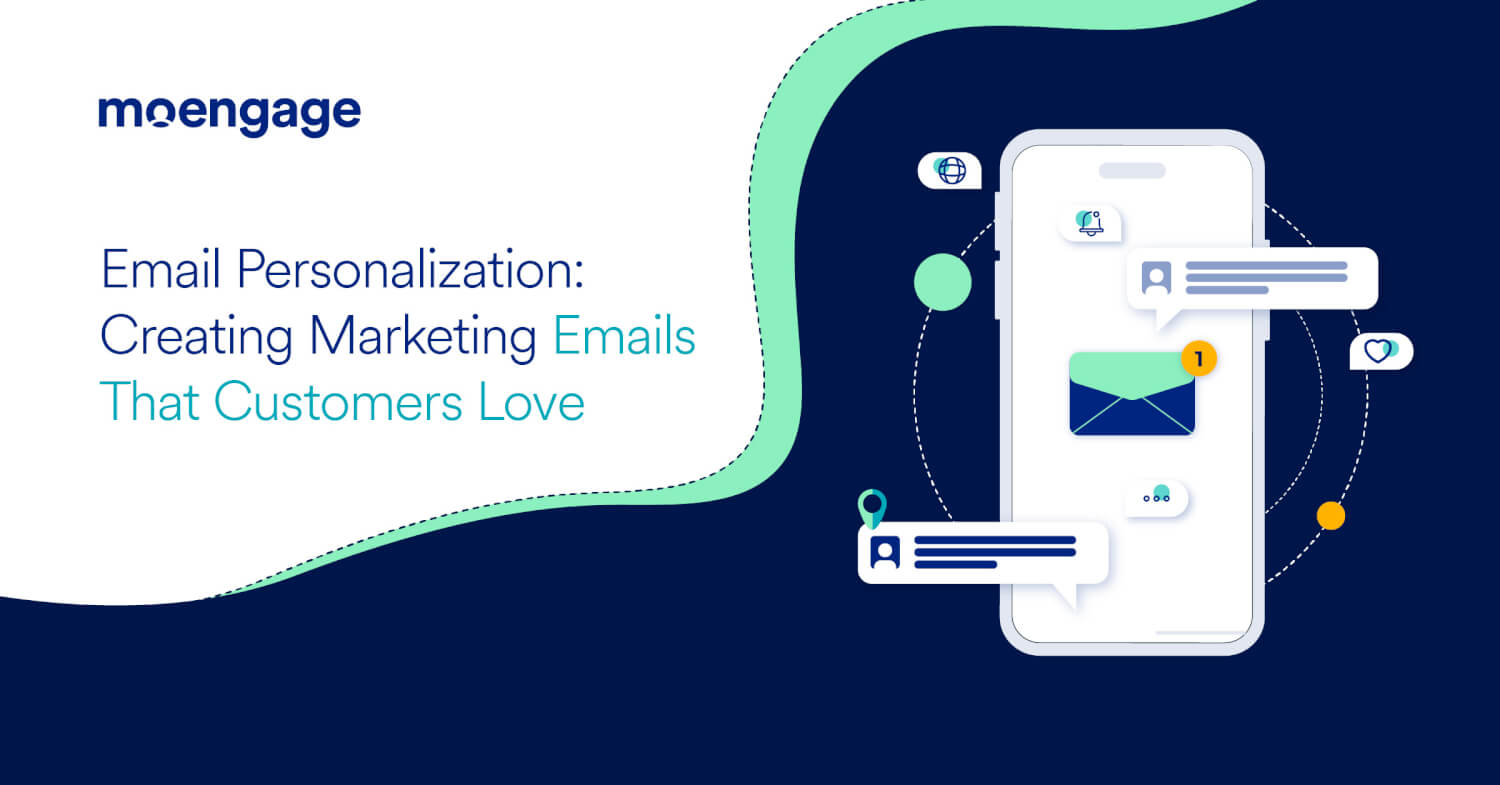
Reading Time: 13 minutes
According to the State of Cross-Channel Marketing report, email is the most commonly used channel for marketing, with over 80% of B2C marketers saying they use it. Even more importantly, the majority said that email was their organization’s most effective engagement channel.
But to get real value from your email marketing efforts in today’s age, you need to make sure they are personalized to your customers.
Email personalization is non-negotiable for marketers who have any intention of remaining relevant. In a sea of generic messaging, audiences want content that speaks to them.
This article discusses what makes email personalization so critical in modern marketing, how to go about personalizing marketing emails, and provides concrete, real-life examples for brands to consider.
What is Email Personalization?
Email personalization is a marketing strategy that involves sending customized emails to the recipient, based on their demographics, location, preferences, interests, behaviors, and journey stage.
A truly personalized email goes beyond first name personalization and makes the content feel intended for the specific reader. This greatly impacts email marketing metrics such as click-through rates and conversions, as can be seen in MoEngage’s Customer Engagement Benchmarks 2024 – North America Edition.
However, many marketers still admit that creating effective instances of personalized marketing a challenge. This blog is intended to help with that.
What is the difference between email segmentation and personalization?
Segmentation is the process of defining customer profiles based on customer demographics, location, behavior, and interests, and then using that information to determine what messages are relevant to different customer groups.
Personalization is the opportunity presented by that process. Insights derived from segmentation allow you to deliver a unique, seemingly bespoke experience to each customer through use of these segmented profiles. The insights from segmentation ensure that the marketing communication you send is delivered at the right time and is impactful, further improving email metrics such as open rates, click-through rates, and overall engagement. Essentially, personalization empowers you to speak to each particular segment individually.
More simply, segmentation tells who you should and shouldn’t send a particular email to; while personalization helps you define what you send to each person.
Why is Email Personalization Critical in Marketing?
Each email presents a multitude of opportunities to personalize from the subject to the signature. Few marketing opportunities give you as many touch points tied up in the same convenient package. Overall, email personalization helps to:
- Improve open and click-to-open rates: Catching the customer’s attention with a catchy and personalized subject line and preview message makes them more likely to not only open the email, but also click the intended link/attachment.
- Ensure customer engagement: Keep customers actively engaged and in-the-loop with updates on recent orders and transactions, news of the latest offers, loyalty rewards benefits, and other brand communication.
- Enable orchestrated omnichannel customer journeys: Email personalization empowers teams to connect with customers on an additional channel touchpoint that can be incorporated into an omnichannel flow. This provides greater brand visibility and pushes users further down the conversion funnel.
- Increase conversions: Personalized recommendations and offers sent via emails are far more enticing, eliciting greater clicks, engagement, and — ultimately — sales. Personalized emails can also result in customers opting in to communicate via other channels (like SMS) or get them to download your mobile app.
- Reactivate (potentially) dormant customers: Timely, personalized email campaigns can be used to reach and engage customers that have a high propensity to become inactive or churn or reactivate those that have already become dormant or churned.
- Enhance the customer experience: Personalized emails that deliver relevant recommendations, promotions, and communication to customers enhances their experience with — and impression of — your brand. This impacts customer retention.
Below we provide key statistics surrounding email personalization and email marketing benchmarks that can be achieved through different types of personalization.
Email Personalization Statistics and Benchmarks
Personalized experiences are no longer optional; customers expect them from the brands they use regularly.
According to our Customer Engagement Benchmarks 2024 report, different types of email personalization help brands significantly increase open rates (OR), click-to-open rates (CTOR), and conversion rates (CVR).
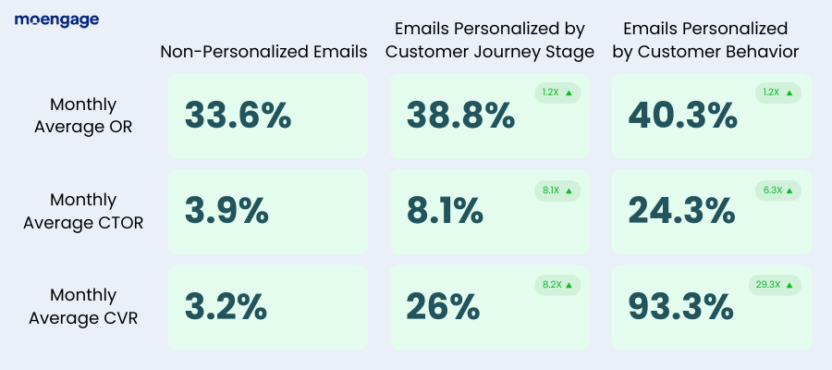
These benchmarks provide the following insights:
- Customers are 1.2X more likely to open emails personalized according to their journey stage as compared to generic messages.
- Customers are 1.2X more likely to open emails personalized according to their behavior as compared to generic messages.
- Customers are 2.1X more likely to click emails personalized according to their journey stage as compared to generic messages.
- Customers are 6.3X more likely to click emails personalized according to their behavior as compared to generic messages.
- Brands can experience 8.2X higher CVR when they use customer journey insights to personalize email communication instead of sending generic messages.
- Brands can experience 29.3X higher CVR when they use customer behavior insights to personalize email communication instead of sending generic messages.
There’s no doubt that personalized emails perform better than non-personalized emails, with behavior-based personalization impacting performance most. Not only do they get a lot more eyes on your emails, but they drastically increase CTOR and CVR, showing they resonate with customers far more than generic emails.
What to Personalize in a Marketing Email
We’ve already established that email personalization is important but there’s more to it than customizing the email on the basis of first name.
Personalization isn’t just about knowing basic demographic details like your customer’s name and age, it’s about understanding where they are in the customer journey, their preferences, and their actual behavior. Are they in the middle of the flow of the sales funnel and need a reminder to re-engage? Have they recently made a purchase and you want to incite positive feedback?
There are so many different components to an email that can be personalized. Below, we look at what you can — and should — personalize in your emails.
Subject Lines
An email subject line is the first thing the customer is going to engage with, and it can be the difference between them opening or deleting the message. Subject lines need to be direct and to the point, communicating as much information as possible while still enticing customers to click.
Preview Snippet
Notifications on both web and mobile often display email previews before they are opened. Craft personalized content for this preview and make sure it’s tailored to entice customers to open the email.
Main Copy
This is the segment of the email where you need to drive impact home while still getting to the point. Storytelling is important, but your customer’s time is precious. While your email needs to be crisp and engaging throughout, you need to avoid the need for scrolling too much (unless you are certain you can keep the customer’s attention).
Ensure the copy has highly relevant and contextual recommendations that are aligned to your customers’ behavior, buying patterns, and usage trends. Furthermore, adding personalized deals that are relevant to the customers helps to set your brand apart, incentivize active engagement, and leads to conversions.
Dynamic Content
Grab customers attention and motivate engagement with dynamic content like images, videos, and gamified elements like scratch cards and spin-the-wheels. These elements can be differentiated based on the email use case, e.g. cart abandonment or search drop off. But make sure this is not a heavy file and will load and display properly on different browsers and mobile devices.
Call-to-action (CTA)
Your email also needs to have at least 1 personalized CTA that can be tracked. For example, download our app, sign up for SMS, continue shopping, read this asset etc.
Timing
Email scheduling is just as important as the content itself. Sending emails at irrelevant timings can lead to the customer overlooking them or cause frustration. Make sure you are hitting your customers when the data indicates they are prone to engage. Leverage AI to help you find the best time and day to send messages to individual customers.
Frequency
How often a customer receives communication can be the difference between active, consistent engagement and someone opting out of email campaigns altogether. Effective customer segmentation enables brands to perfect the frequency of campaigns to maximize engagement and keep customers happy. For e.g. price-conscious customers can be sent more emails during sale time to promote the attractive offers and get them to convert.
AI enables you to conduct automatic A/B testing and figure out the best frequency for different customers and segments. Either way adding a frequency capping is essential to ensure customers don’t feel spammed.
For best results, B2C marketers will want to personalize all of these elements, optimizing each component over time to improve traction and engage customers more effectively.
Email Personalization Best Practices: Strategies for Success
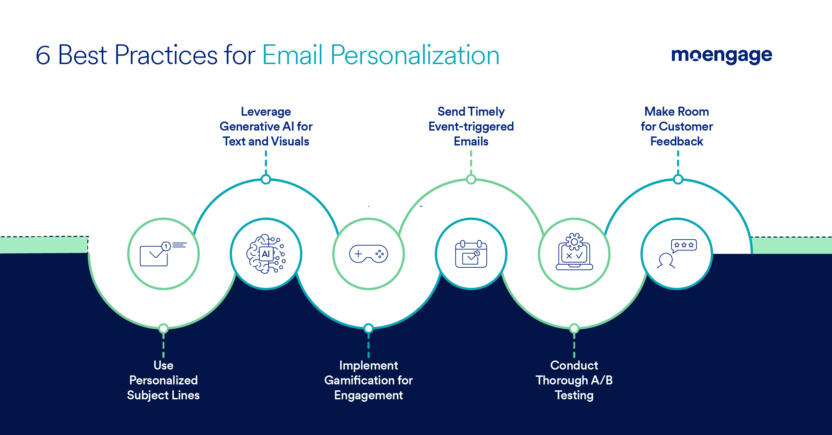
There are lots of ways to incorporate personalization in email marketing, so we’ve compiled a list of strong strategies to get you started.
1. Use personalized subject lines that grab your customers attention
The subject line is the first thing the customer sees. If it doesn’t make an impression, you stand to lose the customer within seconds. Personalization starts with communication that feels human to human.
However, since the character count is limited, you need to be crisp and precise in conveying your message and personalizing the subject line.
Give recipients an idea of the content and context of your emails by conveying whether the email is informative, promotional, or transactional directly in the subject line.
You can even use subject lines to create a sense of urgency on time-sensitive campaigns, encouraging prompt engagement.
Customized subject lines are a great way to cater emails for special occasions, like a customer’s birthday. Instead of adding a generic subject line, grab your customer’s attention by addressing them directly and offering them a personalized reward.
Emojis are another great way to not only lighten the tone of your emails and catch your audience’s attention, but also to convey ideas and tone in a short amount of characters, which is great for subject lines as they have strict limits on character length.
2. Leverage generative AI to create enticing email copy and visuals
Save your organization significant time managing your email marketing campaigns with generative AI that can create high-performing copy and visuals for subject lines, preview snippets, and the main copy.
Generative AI can analyze past campaign performance, understand context based on your particular audience and use case, and consider the positive and negative connotations and reactions to your email campaign copy.
Based on campaign performance, it can then help you personalize and optimize your email copy over time to improve performance and build successful campaigns.
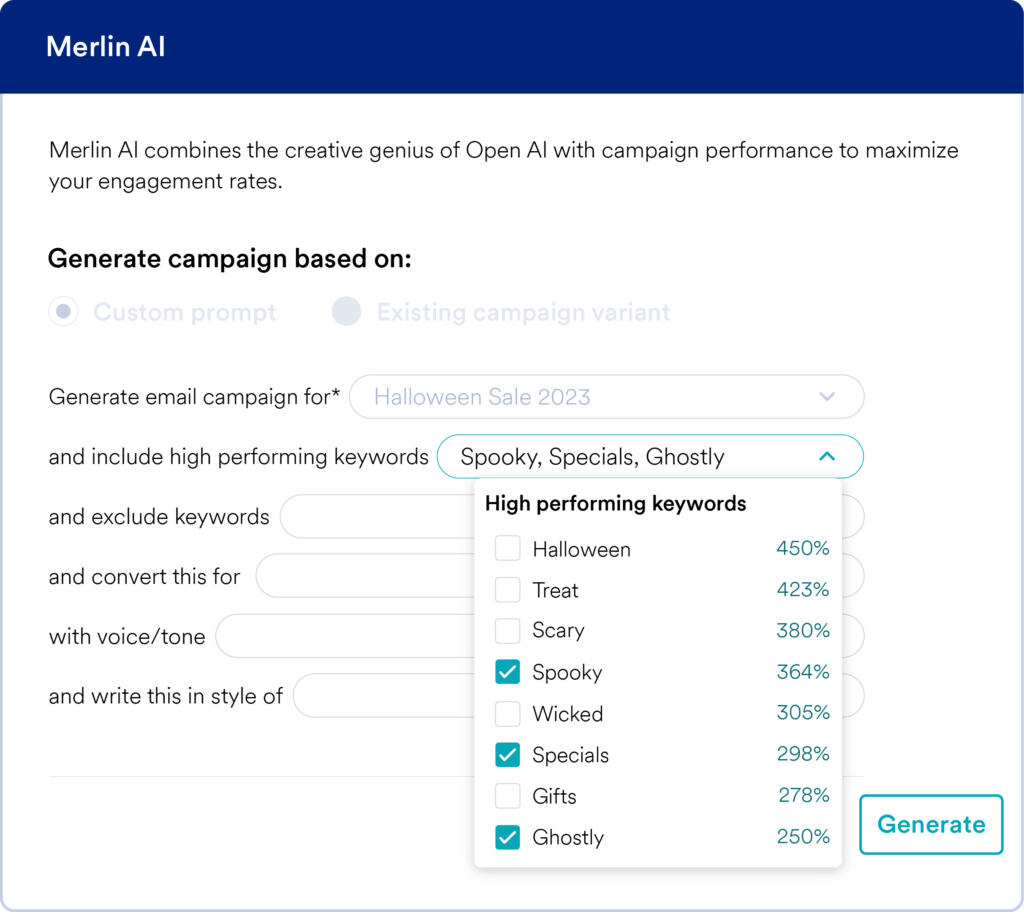
3. Implement gamification to supercharge email engagement
Gamifying elements in your marketing communication is a great way to both enhance and encourage engagement with your brand and drive conversions.
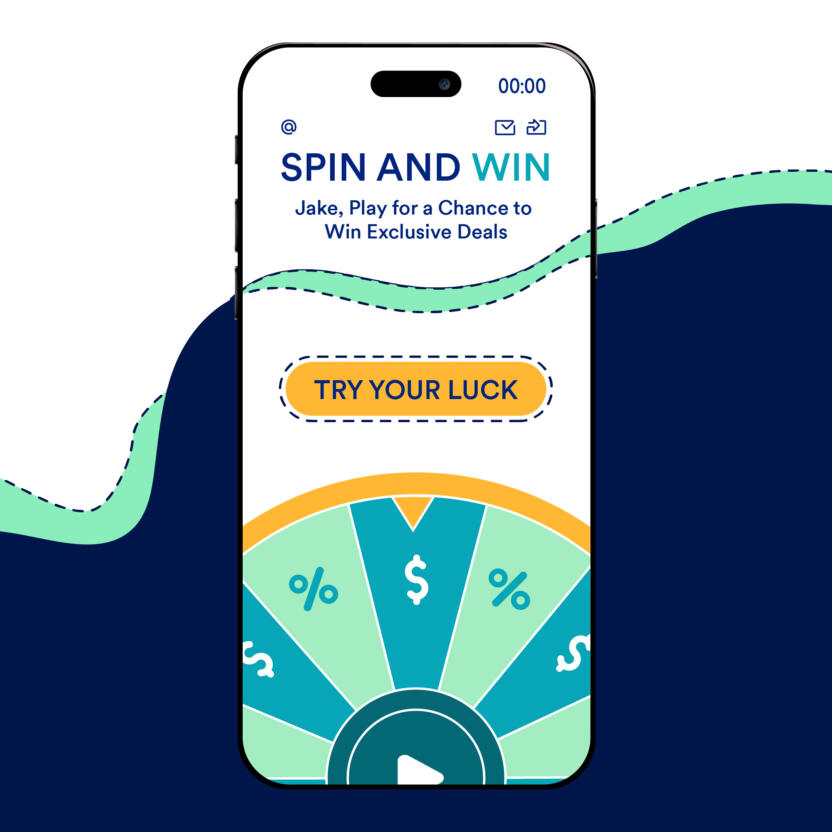
Add interactive elements (like a live sale timer) and games (like “spin-the-wheel” and “scratch cards”) that entice customers to participate in promotional offers. This is a great way to get customers to actively engage with your emails, ensuring they click-through to perform other actions, such as taking advantage of the offer they get.
Not only that, these gamified rewards incentivize customers to open future emails so they can play again and win attractive offers. For this reason, gamification is not only great at driving immediate engagement, but it’s also a valuable tool in evoking consistent engagement with your emails, as customers will be waiting for monthly, weekly, or even daily scratch cards or wheel spins.
4. Send event-triggered emails that arrive at precisely the right time
Timing is everything when it comes to email engagement. If your email doesn’t come at the right time, it will remain unopened or will be deleted months later when they clear out their junk mail.
To make sure you always send your emails at the right time and with the right context, set up event-trigger based marketing campaigns that automatically trigger when a customer takes a particular action. These events can be pre-determined and set up in your customer engagement platform’s dashboard, automatically triggering when a customer completes onboarding, completes a purchase, abandons their cart, or when their membership is about to expire in a week.
This ensures they receive messaging in a timely fashion, while it’s still relevant, drastically increasing open and engagement rates.
5. Conduct thorough A/B testing to make data-driven improvements
It’s not easy to perfect the content, timing, and frequency of your email marketing campaigns. It takes trial and testing to learn what works and what doesn’t. And even then, it can be difficult to identify the difference between a smash hit and an absolute flop.
B2C brands that use AI-based, dynamic A/B testing are able to get reliable insights into what is — and isn’t — working so they can optimize their email marketing campaigns to increase OR, CTOR, and CVR.
6. Give customers the ability to provide feedback
Customers should be given the power to decide the frequency of emails they receive and be able to give feedback on the content they are receiving.
For this, you can add a CTA at the bottom of your emails asking them to leave feedback or even send periodic feedback request emails. But make sure you respond quickly to such feedback, make improvements, and communicate those back again to your customers or you could risk churn.
5 Best Email Personalization Examples From Top B2C Brands
Knowing the strategies to implement and executing them effectively are two different things. Let’s look at some real-life examples of personalized email marketing campaigns to see how leading brands drive engagement, conversion, and retention.
1. Duolingo reactivates customers with humor
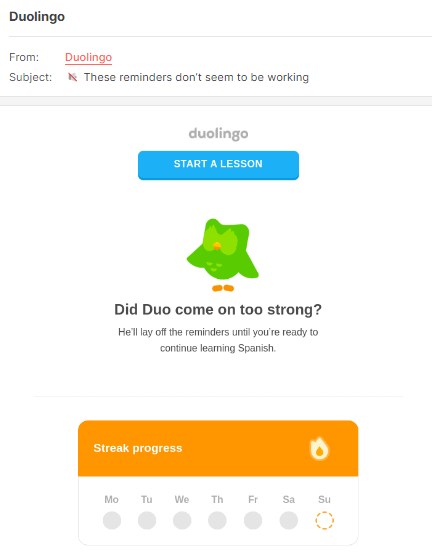
Duolingo is known for its content game and tongue-in-cheek marketing campaigns that often tease customers for lapsing in their language studies. This personable and conversational style goes a long way to bridge the gap between the brand and customers who have become disengaged.
But Duo isn’t just an adorable green bird, it’s a savvy marketer using customer segmentation to target — and reactivate — inactive customers and reduce the potential for customer churn.
They use creative, fun email campaigns to remind customers of their streak progress when they’re falling behind on their courses, encouraging them to get back to learning and keep them on pace.
2. Adidas mitigates cart abandonment with event-triggered emails
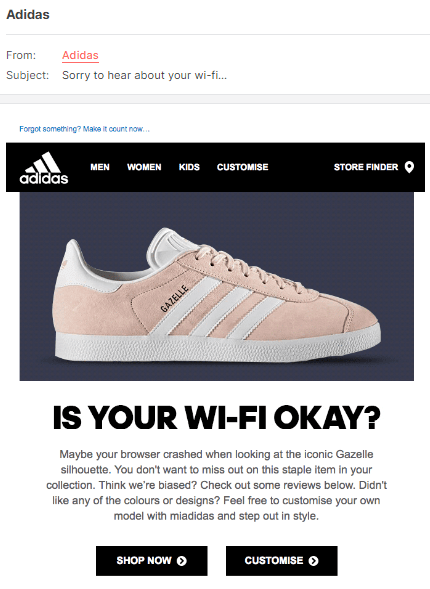
Adidas also uses a tongue-in-cheek communication for certain campaigns which imply that customers that left a checkout incomplete must have had a technical error. This is a light-hearted way of alerting customers of an abandoned cart and is extremely effective at increasing conversions.
Such unique, quirky, and contextually relevant email campaigns resonate well with customers and help you deliver an optimal experience at the exact times customers abandon their cart.
3. McDonald’s motivates customers to convert with personalized offers
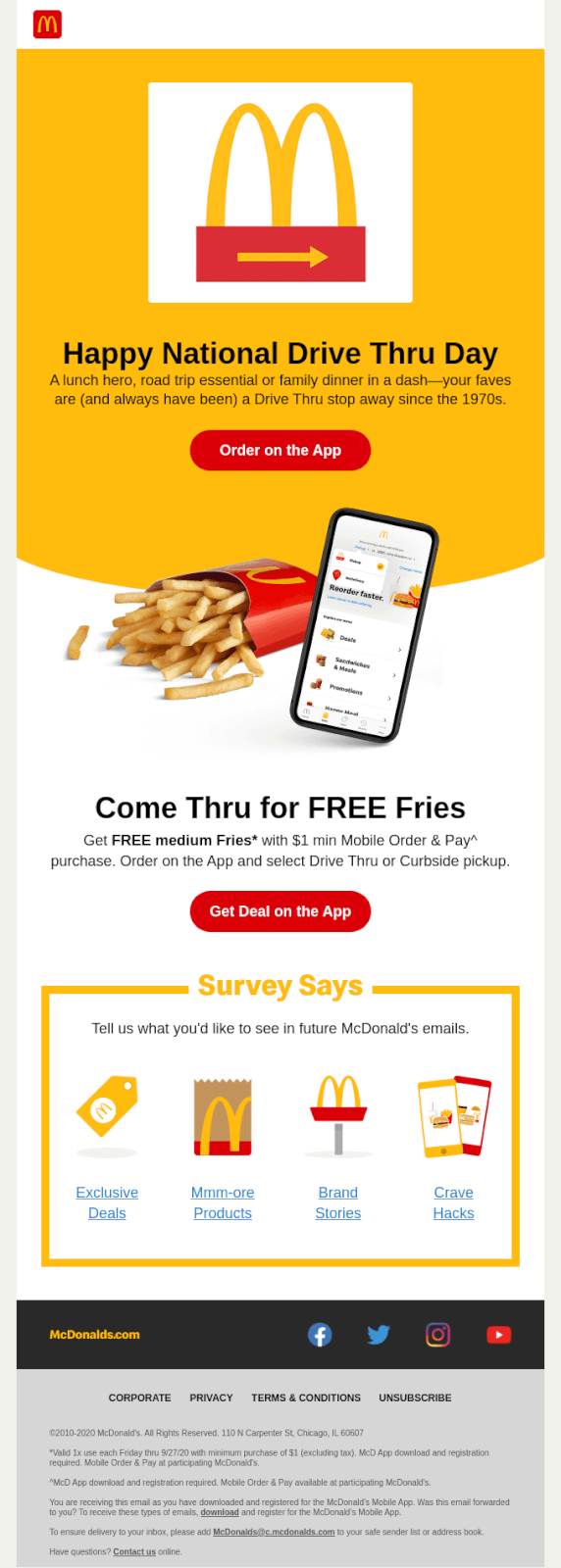
McDonald’s sends regular emails to its customers to keep them engaged. Often the intent of these is to entice them with attractive offers that’ll get them to open the app and place an order.
They also collect customer feedback using surveys to help them engage customers more effectively in the future, attempting to understand what types of content customers want from their future emails.
4. Rocket Money sends customized financial updates to improve customer satisfaction
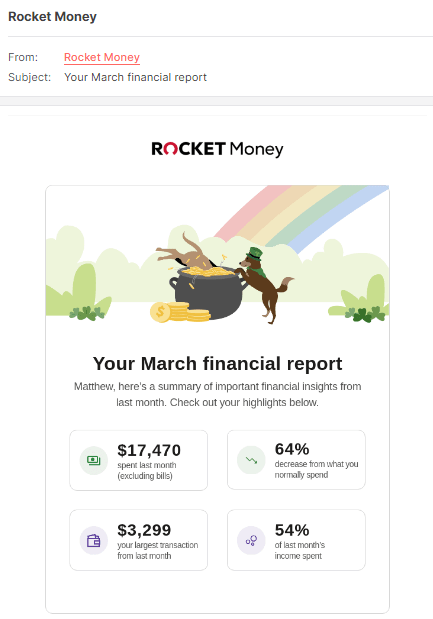
Email marketing isn’t always about direct sales, it’s also about sending crucial information to your customers that enhances their experience.
Rocket Money sends customized financial reports via emails to their customers that summarize their monthly activity. These emails contain deep insights into their spending habits and help customers with personal financial management.
Providing customers such helpful, personalized, and relevant emails drastically increases engagement with email campaigns, from OR to CTOR.
5. Netflix reactivates customers with targeted emails
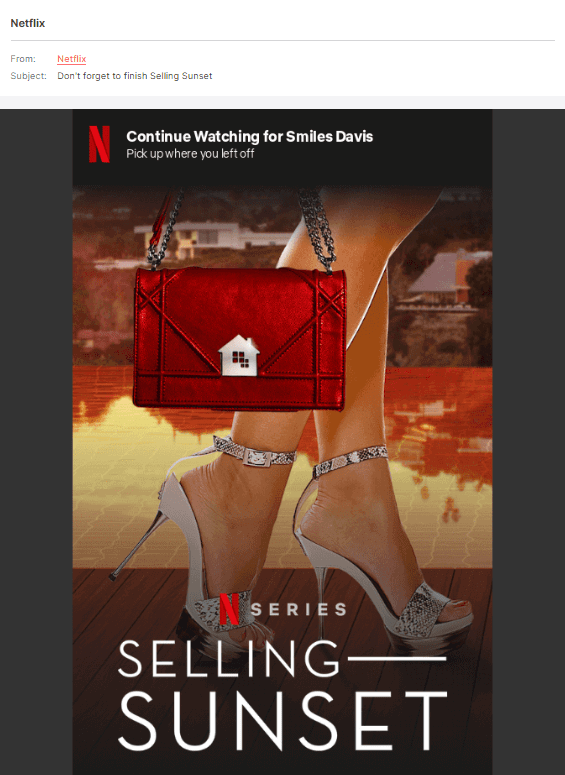
Netflix analyzes every single interaction their customers make with the platform so they can understand their preferences better. Then they leverage the wealth of information — like in-app activity and watch history — to deliver hyper-personalized recommendations that keep customers engaged and reactivate customers that have gone dormant.
For example, the above email from Netflix is providing a fully personalized recommendation based on the individual customer’s recent activity, reminding them to return to the app and continue watching their favorite series.
Keen on driving engagement and conversions with campaigns like those above? Personalizing your emails gets a lot easier and more scalable with the right email personalization software.
How to Choose the Right Email Personalization Tool
You can’t make your audience feel special unless personalization is done right. Here are some features to look for when comparing email personalization tools:
1. Customizable Templates
The tool should let you create dynamic emails using templates you can customize as per the recipients’ needs. It includes changing colors, adding images, and using the right CTA buttons. Does it also allow you to drag and drop different elements in your email without using any code? Even better!
2. Customer Segmentation
You should be able to segment your customers and prospects into different groups like inactive customers, loyal customers, cart abandonments, and more. Such segmentation makes it easier to send hyper-personalized emails in real-time, like product recommendations, based on the group the recipient belongs to.
3. Email Automation
From scheduling reminders and sending nurture emails to new subscribers, to sending coupons and subscription renewal emails, the tool should automate it all. Email marketing automation ensures that a personalized email is sent to the right audience whenever customers trigger the desired action. For example, an order confirmation email should be automatically sent to a customer who completes a transaction.
4. Analytics
Another consideration when choosing email personalization tools is email analytics. Select a tool that allows you to analyze email open rates, bounce rates, and other key metrics that can help you understand whether your email personalization strategy is working or not.
5. Ease of Use
Finally, the email personalization tool you pick should be easy to use. Not just for you, but for the rest of your team, too! Because if the tool comes with a steep learning curve, you don’t want the ROI to decline due to associated training costs, right?
Send Highly Personalized Emails That Your Customers Will Love —With MoEngage
Email is one of the most commonly used marketing channels. Because of this, modern consumers receive an abundance of emails that never get opened. For your emails to stick, you need to be giving customers hyper-personalized emails that speak directly to their needs, preferences, and where they are in the customer lifecycle.
MoEngage’s Customer Engagement Platform (CEP) can help you personalize the content, timing, and frequency of your emails so you can deliver communication that resonates with your customers.
With MoEngage’s generative AI engine — Merlin AI — you can automate copy creation and campaign optimization, freeing up time to develop future campaigns.
Use Sherpa AI to A/B test your email campaigns and find out things like ‘best time to send’ to hone in on what’s most effective, allowing you to increase engagement.
Whether you’re a retailer, a quick service restaurant (QSR), a bank or financial institution, or a media & entertainment company, we can help you deliver engaging marketing emails that drastically increase OR, CTOR, and CVR.
Schedule a demo today to find out more about how we can help you execute a flawless email marketing campaign at scale.
















